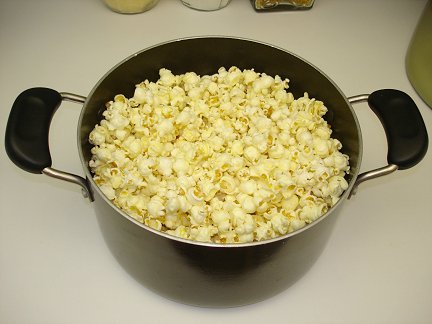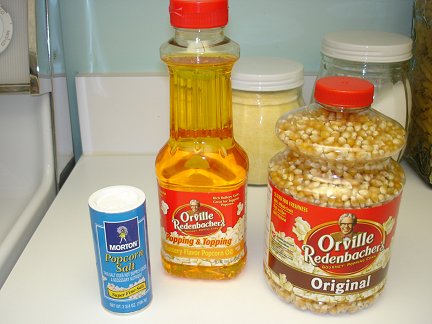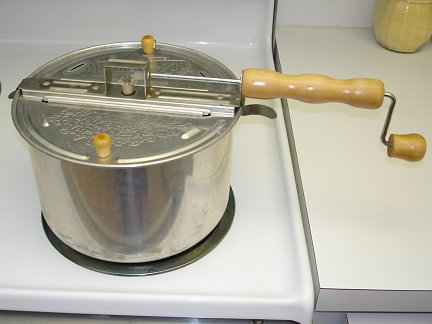 You are probably asking yourself, "Why a recipe for popcorn?" Popcorn is too easy. Everybody knows how to make it. You just nuke a
bag of microwave popcorn and in 2 minutes you are ready to eat with no muss or fuss, right? Wrong. I hate microwave popcorn.
You are probably asking yourself, "Why a recipe for popcorn?" Popcorn is too easy. Everybody knows how to make it. You just nuke a
bag of microwave popcorn and in 2 minutes you are ready to eat with no muss or fuss, right? Wrong. I hate microwave popcorn.
I have been a popcorn lover for as long as I can remember. It is by far my favorite snack food. It was a wonderful treat made by my
parents and grandparents when I was growing up. I learned from them the art of making perfect popcorn the old-fashioned way, on the
stove-top. When microwave popcorn came along, I thought I was going to be in popcorn heaven, It was going to so much easier and
quicker to make my favorite snack. Unfortunately, I just don't like the taste of most microwave popcorn. There are only a few brands
I even consider to be edible. None of them are anywhere near as good as popping it yourself on the stovetop.
In my family, popcorn was almost always made by the men of the house. My grandfather and father were the ones who always made the popcorn.
They had techniques that almost always resulted in perfect popcorn. My grandfather especially, who I inherited my science geekery from,
approached popcorn popping as a science. He strove to perfect it and make it perfectly repeatable. I have built on his technique, using
hardware he could only have dreamt of, I can make perfect popcorn every time in only a few minutes. Here's how.
 The recipe for popcorn is pretty simple. Just oil, popcorn and heat. Salt, butter, and seasonings are all optional.
I usually just eyeball the correct amount of oil. If I were to measure it, it would be around 3 tablespoons.
I always measure out the correct amount of popcorn though. Too much will blow the top off the popper and make a mess. Too little leaves the corn
swimming in excess oil. I always use 1/2 cup of corn. The oil
serves as a way to conduct heat into the popcorn kernels as efficiently as possible. The oil will provide a better heat conductive
path between the bottom of the popper and the popcorn kernels than if the bare kernels were just sitting on the bottom of the hot popper.
It doesn't take much oil for this function. Only about a tablespoon or so for even a fairly large amount of popcorn. However, since I
prefer to use a flavored oil, I use more than is absolutely necessary for good popping in order to flavor the popcorn too. If you don't
want to use flavored oil, and like your popcorn plain, or plan to season it or use a butter topping, you can get by with much less. I like Orville
Redenbacher's flavored popping oil. I also like his original yellow popcorn. It produces very consistent and tasty results.
The recipe for popcorn is pretty simple. Just oil, popcorn and heat. Salt, butter, and seasonings are all optional.
I usually just eyeball the correct amount of oil. If I were to measure it, it would be around 3 tablespoons.
I always measure out the correct amount of popcorn though. Too much will blow the top off the popper and make a mess. Too little leaves the corn
swimming in excess oil. I always use 1/2 cup of corn. The oil
serves as a way to conduct heat into the popcorn kernels as efficiently as possible. The oil will provide a better heat conductive
path between the bottom of the popper and the popcorn kernels than if the bare kernels were just sitting on the bottom of the hot popper.
It doesn't take much oil for this function. Only about a tablespoon or so for even a fairly large amount of popcorn. However, since I
prefer to use a flavored oil, I use more than is absolutely necessary for good popping in order to flavor the popcorn too. If you don't
want to use flavored oil, and like your popcorn plain, or plan to season it or use a butter topping, you can get by with much less. I like Orville
Redenbacher's flavored popping oil. I also like his original yellow popcorn. It produces very consistent and tasty results.
My grandfather taught me that there are several tricks to getting perfect popcorn with no burned kernels and few unpopped
kernels (old maids). The main trick is that all the kernels need to be heated evenly so they will all come up to popping temperature at
about the same time. If they are heated unevenly, the first to pop will start burning before all the rest have a chance to pop. You
will wind up with both burned kernels and lots of old maids. That's not good popcorn. There are two ways to get even heating of the
oil and popcorn. The first is to use a heavy, thick popping vessel that will distribute heat evenly. The other way is to use a thin,
light popping vessel, but keep the oil and popcorn constantly agitated to prevent uneven heating from the hot and cold spots you always
have in a thin pot. I take the second approach.
 This is my Whirley-Pop popcorn popper. It was given to me as a Christmas gift several years ago. People know I love popcorn. I see these all
the time at yard sales you can pick up one used cheap. You don't need a Whirley-Pop to make good popcorn, it just makes it easier. You can do
about as well with any large, thin-walled vessel with a loose-fitting lid. The Whirley-pop is made of thin, light-weight aluminum. It no doubt
suffers from terrible hot and cold spots due to the thinness of the metal and the uneven heating of the stove burners. This isn't a problem though
if you constantly agitate the oil and corn as it heats up and pops. The Whirley-Pop has a built in stir bar in the bottom that is turned by a
crank on the end of the handle. The stir bar does a great job of agitating the oil and corn.
This is my Whirley-Pop popcorn popper. It was given to me as a Christmas gift several years ago. People know I love popcorn. I see these all
the time at yard sales you can pick up one used cheap. You don't need a Whirley-Pop to make good popcorn, it just makes it easier. You can do
about as well with any large, thin-walled vessel with a loose-fitting lid. The Whirley-pop is made of thin, light-weight aluminum. It no doubt
suffers from terrible hot and cold spots due to the thinness of the metal and the uneven heating of the stove burners. This isn't a problem though
if you constantly agitate the oil and corn as it heats up and pops. The Whirley-Pop has a built in stir bar in the bottom that is turned by a
crank on the end of the handle. The stir bar does a great job of agitating the oil and corn.
Once the oil and corn are in the popper, I put it on the biggest burner on the stove
and turn it on to the highest setting. Really pump those BTUs into the popper. Agitate the popper frequently as it heats up. I find that
shaking the popper works best in the beginning. The stir bar tends to fling the kernels out to the edge of the popper, which is the coolest part.
I want the kernels to get hot, so I don't start cranking it until the popping gets going in earnest. There will be a few
early pops, then they will start firing off at a rapidly accelerating rate. That is when I start cranking, and I don't stop until
I am ready to dump the popcorn out of the popper. The rate of popping will become
tremendous since the kernels are all about the same temperature, they are all trying to pop at once. When this crescendo of popping is reached,
I turn off the burner and let the residual heat finish the job. Within only a few seconds, almost all the kernels will be popped. The rate of
popping will die down to almost nothing. Remove the popper from the still hot burner. Give it a couple more cranks, and dump the contents
into a large bowl before any of the kernels have a chance to burn. Salt to taste (if so inclined) with either popcorn salt, or kosher salt
ground to a fine powder in a spice grinder.
If you like to put real butter on your popcorn, (I do sometimes too), I recommend using clarified butter. Ordinary butter is actually an emulsion
of water, fat and protein. If you just melt some butter and pour it over your popcorn, the result will be terrible. The water in the butter will
make your perfectly popped kernels shrivel up and turn into hard, pasty lumps. Clarified butter is butter that has been melted and allowed to
fully separate into its various components. The fat portion is then re-solidified and sold as clarified butter. It has little or no moisture
content and won't shrivel up your popcorn.
You can make your own clarified butter at home if you can't find it in the store. Just melt some butter
at low temperature (a double boiler works well). Pour off the melted butter into a plastic container, and let it sit for a few minutes to fully separate.
It will be easier to see the different layers if you use a tall transparent container. But it will be easier to get the resulting clarified butter out
if you use a wider, shallower container. The water will sink to the bottom. The oil will float on top of that. I usually do a half pound of butter in
a batch and that lasts me a long time. Once separated, put the container in the fridge until the oil re-solidifies.
It is usually pretty easy to get the "puck" of solidified oil out of the container. Discard the milky water layer in the bottom of the container. Dry
the bottom of the puck where it was in contact with the water by patting it with a tea towel. Break or cut the amount of butter you want to use off
the puck and melt it, being careful not to burn it, and pour over your popcorn. Clarified butter is used in lots of other recipes too. Store the puck
of clarified butter in an air-tight container in your fridge. It should last quite a while before going rancid.
Enjoy!